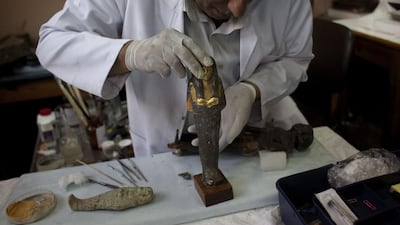Here is an idea that will almost certainly not fly politically, but economically which makes a lot of sense.
Egypt is overflowing with antiquities. So much so that they are stuffed away to moulder in warehouses, sometimes forgotten and allowed to deteriorate, never to be seen again by the public or by researchers.
Why not package up some of these artefacts and organise their sale to foreigners or Egyptians, complete with documents telling the buyer where the item was found and why it is significant? The government could add tens of millions of dollars to its coffers each year.
It’s not like Egypt isn’t selling antiquities now. The problem is that the sellers are not the government, but rather organised looters who have been plundering the country’s archaeological sites. In the process they have been destroying important historical information that proper archaeology would glean from the objects’ physical contexts.
The pillaging has been going on full force since the 2011 uprising, with digging and looting in sites from Alexandria to Aswan.
The value of the spoils is staggering. A week ago, the news site Live Science published a report, based on US Customs documents, saying international traders had openly declared about $50 million imports in artefacts from Egypt in 2016, the biggest yearly amount in at least two decades.
It is almost certain, though difficult to prove, that the bulk of these artefacts were taken out of Egypt illegally. Among the imports were more than 10 kilograms of antique gold coins.
The $50m is almost certainly an underestimate. Importers tend to understate the value of objects, and many others bring objects in without declaring them to customs.
And that is just a single country. One has to assume that a steady stream has been flowing into wealthy countries in Europe, the Gulf states and the Far East as well.
Even without the looting, Egypt has been getting little benefit from many of the artefacts. When an archaeological site is excavated, typically the archaeologists are required to place all the objects they find in warehouses. The public is not allowed to visit and view them, and they usually are not accessible for study. Even the archaeologists working on the project often can’t get back to study them once they have delivered them to the magazine.
By now, the number of such pieces hidden away in countless magazines probably runs into the hundreds of thousands. The objects are often moved with corresponding loss of information and occasionally stolen.
One of the most common of the artefacts is the shabti, a small carved figurine that wealthier ancient Egyptians would place inside their tombs to represent their servants and workers, who would accompany them into the afterlife to continue serving. These shabtis are often elegant, with hieroglyphic writing on their legs.
Because they were so popular in ancient Egypt, tens of thousands have been uncovered, sometimes several hundred in a single tomb. As a result they are now common in museums around the world, acquired before Egypt began restricting the export of antiquities in the 1970s and ‘80s.
Similarly popular were scarabs, or beetle amulets, often used to protect mummies.
There are so many of these objects that most no longer have use in research, museums or academia.
A foreign Egyptologist tells me that until the 1970s the Egyptian Museum in Cairo had a sale room for surplus antiquities, and until the ‘80s foreign archaeologists excavating a site were given a proportion of the finds.
One important effect of again legalising the export of artefacts would be to direct at least a part of the current illicit trade into official channels. Instead of smugglers reaping the gains, the revenue would go to the state treasury.
This is particularly urgent. Since the collapse of tourism after the 2011 uprising and subsequent political turmoil, ticket sales have plummeted and antiquities have been starved of funds. Egypt needs more revenue to operate its museums, restore more important artefacts and preserve and protect its main archaeological sites.
The objects could be given official registration with papers, which would make them more valuable on the international market since their provenance would be documented, making them legally tradable. They could be digitally scanned before the sale, and conditions could be put that the buyer will make the object available to researchers if necessary.
Alas, it will probably not happen. Last week a television station asked in an online poll if Egypt should sell antiquities to solve its economic crisis. Critics of the government immediately went on the attack, accusing it of being behind the poll. Said one online opposition newspaper: “After the regime sold the country … it’s going to sell our history and civilisation.”
Patrick Werr has worked as a financial writer in Egypt for 26 years.
business@thenational.ae
Follow The National's Business section on Twitter

